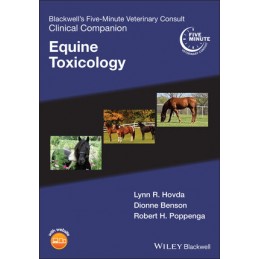- Obniżka


 Dostawa
Dostawa
Wybierz Paczkomat Inpost, Orlen Paczkę, DHL, DPD, Pocztę, email (dla ebooków). Kliknij po więcej
 Płatność
Płatność
Zapłać szybkim przelewem, kartą płatniczą lub za pobraniem. Kliknij po więcej szczegółów
 Zwroty
Zwroty
Jeżeli jesteś konsumentem możesz zwrócić towar w ciągu 14 dni*. Kliknij po więcej szczegółów
A clinical quick-reference guide to managing toxicants in horses
Blackwell’s Five-Minute Veterinary Consult Clinical Companion:: Equine Toxicology provides crucial information for managing toxicants in horses in a quick-reference format. The book begins with foundational information on clinical toxicology, including emergency management, antidotes, sample analysis, and necropsy. It then discusses specific toxicant categories and toxicants of concern, organized alphabetically for fast access in emergency situations.
The identically formatted topics offer key information relevant to managing toxicants in horses, plus clinical photographs depicting plants and drugs to help clinicians and students identify toxicants. A companion website presents the figures from the book for download in PowerPoint.
This book is the ideal clinical resource for busy practitioners seeking immediate access to life-saving information in time-sensitive emergencies. It places all the information the reader needs to manage toxicants in horses at their fingertips, with full color images and concise bullet points.
Blackwell’s Five-Minute Veterinary Consult Clinical Companion:: Equine Toxicology features::
Blackwell’s Five-Minute Veterinary Consult Clinical Companion:: Equine Toxicology is an indispensable reference for veterinary clinicians and students dealing with equine medicine, as well as for anyone seeking concise and comprehensive information about equine toxicology.
Opis
Contributors List
SECTION 1 CLINICAL TOXICOLOGY
Chapter 1 Forensic Investigation of Equine Intoxications
Chapter 2 Necropsy Analysis
Chapter 3 Laboratory Testing Considerations
Chapter 4 Treating an Intoxicated Animal: Antidotes and Therapeutic Medications
Chapter 5 Compounded Medications
SECTION 2 SPECIFIC TOXINS AND TOXICANTS
Drugs: Illicit and Recreational
Chapter 6 Cobalt
Chapter 7 Cocaine
Chapter 8 Dermorphin
Chapter 9 Growth Hormones and Secretagogues
Chapter 10 Marijuana
Chapter 11 Methamphetamine and Amphetamine
Chapter 12 Opioids
Chapter 13 Selected Androgen (SARMS) and Estrogen (SERMS) Receptor Modulators
Chapter 14 Synthetic Cannabinoids
Drugs: Prescription
Chapter 15 Antipsychotic Agents – Reserpine and Fluphenazine
Chapter 16 Benzodiazepines
Chapter 17 Beta2 Agonists – Clenbuterol and Albuterol
Chapter 18 Bisphosphonates
Chapter 19 Gabapentin
Chapter 20 Iodine
Chapter 21 Medroxyprogesterone
Chapter 22 Methylxanthines: Caffeine, theobromine, theophylline
Chapter 23 Nonsteroidal Anti-inflammatory Drugs (NSAIDS)
Chapter 24 Thyroxine (Levothyroxine)
Chapter 25 Vitamin D (calciferol)
Insecticides, Herbicides and Farm Chemicals
Chapter 26 Amitraz
Chapter 27 Cholinesterase Inhibiting Carbamate Pesticides
Chapter 28 Cholinesterase Inhibiting Organophosphate Pesticides
Chapter 29 Fertilizers – nitrates, urea, phosphates and others
Chapter 30 Herbicides
Chapter 31 Paraquat and Diquat
Chapter 32 Pentachlorophenol (PCP)
Chapter 33 Pyrethroid and Pyrethrin Insecticides
Ionophores and Growth Promotants
Chapter 34 Ionophores
Chapter 35 Ractopamine
Chapter 36 Zilpaterol
Metals
Chapter 37 Arsenic
Chapter 38 Fluoride
Chapter 39 Iron
Chapter 40 Lead
Chapter 41 Selenium
Mycotoxins / Fungus
Chapter 42 Aflatoxins
Chapter 43 Fescue (Endophyte-infected tall fescue)
Chapter 44 Fumonisins
Chapter 45 Fusaria
Chapter 46 Slaframine
Chapter 47 Tremorgenic Mycotoxins
Other Toxins
Chapter 48 Clostridium Botulinum toxin
Chapter 49 Cyanide
Chapter 50 Sodium Chloride (Salt)
Plants and Biotoxins
Chapter 51 Alsike clover (Trifolium hybridum)
Chapter 52 Blue-Green algae (Cyanobacteria)
Chapter 53 Cardiotoxic plants
Chapter 54 Day blooming Jessamine (Cestrum spp.)
Chapter 55 Death camus (Zigadenus spp.)
Chapter 56 Hemlocks (Conium maculatum and Cicuta spp.)
Chapter 57 Hoary alyssum (Berteroa incana)
Chapter 58 Jimsonweed (Datura spp.)
Chapter 59 Kleingrass (Panicum coloratum)
Chapter 60 Lantana (Lantana camara)
Chapter 61 Locoweeds (Astragalus spp. and Oxytropis spp.)
Chapter 62 Narrow leaf milkweed (Asclepias fascicularis)
Chapter 63 Nightshades (Solanum spp.)
Chapter 64 Oleander (Nerium oleander and Cascabela thevetia)
Chapter 65 Pyrrolizidine Alkaloids
Chapter 66 Rayless goldenrod (Isocoma pluriflora)
Chapter 67 Rhododendrons
Chapter 68 Sudangrass (Sorghum spp.)
Chapter 69 Tansy ragwort (Jacobea vulgaris)
Chapter 70 White snake root (Ageratina altissima)
Chapter 71 Yellowstar thistle / Russian knapweed (Centaurea solstitialis / Acroptilon repens)
Chapter 72 Yew (Taxus spp.)
Rodenticides
Chapter 73 Anticoagulants
Chapter 74 Bromethalin
Chapter 75 Cholecalciferol
Chapter 76 Phosphides
Chapter 77 Sodium fluoroacetate (Compound 1080)
Chapter 78 Strychnine
Toxic Gases
Chapter 79 Air Contaminants – CO, NH3, H2S
Chapter 80 Smoke
Trees
Chapter 81 Black locust (Robinia pseudoacacia)
Chapter 82 Black walnut (Juglans nigra)
Chapter 83 Box elder (Acer negundo)
Chapter 84 Oak (Quercus spp.)
Chapter 85 Red maple (Acer rubrum)
Zootoxins
Chapter 86 Blister Beetles (Epicauta spp. and Pyrota spp.)
Chapter 87 Snakes – Crotalids (pit vipers)
Chapter 88 Snakes – Elapids (coral snakes)
Chapter 89 Spiders – Brown recluse spider and black widow spider
Section 3 Reference Material
Appendix 1 Abbreviations
Appendix 2 Herbicides
Appendix 3 Information Resources for Toxicology
INDEX
Indeks: 54561
Autor: Sharon W. Weiss
Expert Consult: Online and Print
